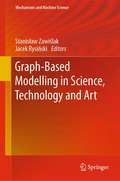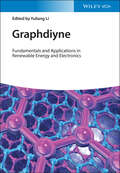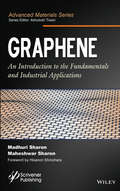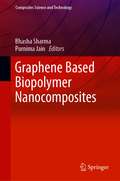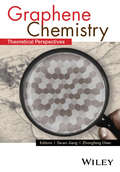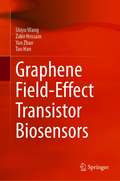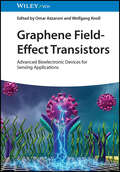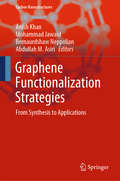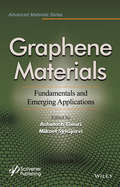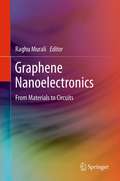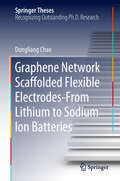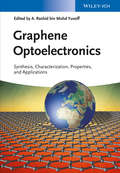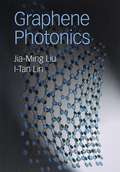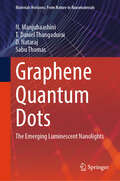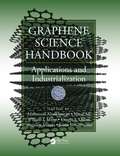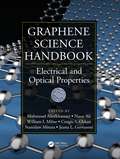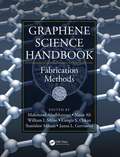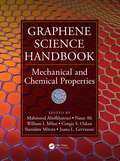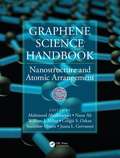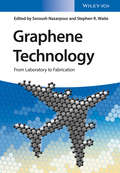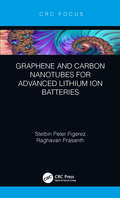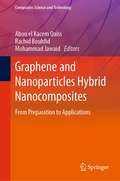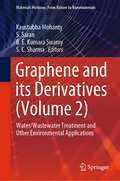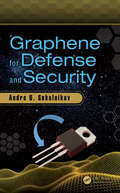- Table View
- List View
Graph-Based Modelling in Science, Technology and Art (Mechanisms and Machine Science #107)
by Stanisław Zawiślak Jacek RysińskiThis book presents interdisciplinary, cutting-edge and creative applications of graph theory and modeling in science, technology, architecture and art. Topics are divided into three parts: the first one examines mechanical problems related to gears, planetary gears and engineering installations; the second one explores graph-based methods applied to medical analyses as well as biological and chemical modeling; and the third part includes various topics e.g. drama analysis, aiding of design activities and network visualisation. The authors represent several countries in Europe and America, and their contributions show how different, useful and fruitful the utilization of graphs in modelling of engineering systems can be. The book has been designed to serve readers interested in the subject of graph modelling and those with expertise in related areas, as well as members of the worldwide community of graph modelers.
Graphdiyne: Fundamentals and Applications in Renewable Energy and Electronics
by Yuliang LiGraphdiyne Discover the most cutting-edge developments in the study of graphdiyne from a pioneer of the field In Graphdiyne: Fundamentals and Applications in Renewable Energy and Electronics, accomplished chemist Dr. Yuliang Li delivers a practical and insightful compilation of theoretical and experimental developments in the study of graphdiyne. Of interest to both academics and industrial researchers in the fields of nanoscience, organic chemistry, carbon science, and renewable energies, the book systematically summarizes recent research into the exciting new material. Discover information about the properties of graphdiyne through theoretical simulations and experimental characterizations, as well as the development of graphdiyne with appropriate preparation technology. Learn to create new graphdiyne-based materials and better understand its intrinsic properties. Find out about synthetic methodologies, the controlled growth of aggregated state structures, and structural characterization. In addition to demonstrating the interdisciplinary potential and relevance of graphdiyne, the book also offers readers: A thorough introduction to basic structure and band gap engineering, including molecular and electronic structure, mechanical properties, and the layers structure of bulk graphdiyne Explorations of Graphdiyne synthesis and characterization, including films, nanotube arrays and nanowires, nanowalls, and nanosheets, as well as characterization methods Discussions of the functionalization of graphdiyne, including heteroatom doping, metal decoration, and absorption of guest molecules Rigorous treatments of Graphdiyne-based materials in catalytic applications, including photo- and electrocatalysts Perfect for organic chemists, electronics engineers, materials scientists, and physicists, Graphdiyne: Fundamentals and Applications in Renewable Energy and Electronics will also find its place on the bookshelves of surface and solid-state chemists, electrochemists, and catalytic chemists seeking a one-stop reference on this rising-star carbon material.
Graphene
by Ashutosh Tiwari Maheshwar Sharon Hisanori Shinohara Madhuri SharonOften described as a "miracle material", graphene's potential applications are extraordinary, ranging from nanoscale 'green' technologies, to sensors and future conductive coatings. This book covers the topic of 'graphene' - the history, fundamental properties, methods of production and applications of this exciting new material. The style of the book is both scientific and technical - it is accessible to an audience that has a general, undergraduate-level background in the sciences or engineering, and is aimed at industries considering graphene applications. As the graphene topic is a broad-reaching and rapidly moving field of research, the aim of this book is therefore to provide information about graphene and its current and future applications that are immediately implementable, relevant and concise. After reading this book, the reader will have sufficient knowledge and background to move forward independently into graphene R&D and to apply the knowledge therein. Although the book will be self-contained, each chapter has copious references to enable further reading, research and exploration of the chapter topics.
Graphene Based Biopolymer Nanocomposites (Composites Science and Technology)
by Bhasha Sharma Purnima JainThe book comprehensively covers the different topics of graphene based biopolymer and nanocomposites, mainly synthesis methods for the composite materials, various characterization techniques to study the superior properties and insights on potential advanced applications.The book will address and rectify the complications of using plastics that are non-degradable and has abhorrent impact on environment. The limitations of properties of biopolymer can be vanquished by employing graphene as a nanomaterial. Outstanding properties of graphene in accordance with biopolymer can be utilized to develop applications like water treatment, tissue engineering, photo-catalysts, super-absorbents. This is a useful reference source for both engineers and researchers working in composite materials science as well as the students attending materials science, physics, chemistry, and engineering courses.
Graphene Chemistry
by De-En Jiang Zhongfang ChenWhat are the chemical aspects of graphene as a novel 2D material and how do they relate to the molecular structure? This book addresses these important questions from a theoretical and computational standpoint. Graphene Chemistry: Theoretical Perspectives presents recent exciting developments to correlate graphene's properties and functions to its structure through state-of-the-art computational studies. This book focuses on the chemistry aspect of the structure-property relationship for many fascinating derivatives of graphene; various properties such as electronic structure, magnetism, and chemical reactivity, as well as potential applications in energy storage, catalysis, and nanoelectronics are covered. The book also includes two chapters with significant experimental portions, demonstrating how deep insights can be obtained by joint experimental and theoretical efforts. Topics covered include:Graphene ribbons: Edges, magnetism, preparation from unzipping, and electronic transportNanographenes: Properties, reactivity, and synthesisClar sextet rule in nanographene and graphene nanoribbonsPorous graphene, nanomeshes, and graphene-based architecture and assembliesDoped graphene: Theory, synthesis, characterization and applicationsMechanisms of graphene growth in chemical vapor depositionSurface adsorption and functionalization of grapheneConversion between graphene and graphene oxideApplications in gas separation, hydrogen storage, and catalysisGraphene Chemistry: Theoretical Perspectives provides a useful overview for computational and theoretical chemists who are active in this field and those who have not studied graphene before. It is also a valuable resource for experimentalist scientists working on graphene and related materials, who will benefit from many concepts and properties discussed here.
Graphene Field-Effect Transistor Biosensors
by Yan Zhao Tao Han Shiyu Wang Zakir HossainIn this monograph, the graphene-based field-effect transistor (FET) biosensors are shown to be an emerging sensing platform. Divided into two parts the first set of chapters are devoted to basic knowledge of graphene, graphene FET and its biosensing. In the second part of this book the applications of graphene FET biosensors combined with various biotechnologies are presented. As well as discussing the existing technologies the authors also introduce their own ideas and concepts. Finally the remaining problems in graphene FET biosensors are discussed, along with proposed solutions and prospects for future applications. This monograph allows readers to grasp the basic knowledge and future direction of graphene-based FET biosensors.
Graphene Field-Effect Transistors: Advanced Bioelectronic Devices for Sensing Applications
by Wolfgang Knoll Omar AzzaroniGraphene Field-Effect Transistors In-depth resource on making and using graphene field effect transistors for point-of-care diagnostic devices Graphene Field-Effect Transistors focuses on the design, fabrication, characterization, and applications of graphene field effect transistors, summarizing the state-of-the-art in the field and putting forward new ideas regarding future research directions and potential applications. After a review of the unique electronic properties of graphene and the production of graphene and graphene oxide, the main part of the book is devoted to the fabrication of graphene field effect transistors and their sensing applications. Graphene Field-Effect Transistors includes information on: Electronic properties of graphene, production of graphene oxide and reduced graphene oxide, and graphene functionalization Fundamentals and fabrication of graphene field effect transistors, and nanomaterial/graphene nanostructure-based field-effect transistors Graphene field-effect transistors integrated with microfluidic platforms and flexible graphene field-effect transistors Graphene field-effect transistors for diagnostics applications, and DNA biosensors and immunosensors based on graphene field-effect transistors Graphene field-effect transistors for targeting cancer molecules, brain activity recording, bacterial detection, and detection of smell and taste Providing both fundamentals of the technology and an in-depth overview of using graphene field effect transistors for fabricating bioelectronic devices that can be applied for point-of-care diagnostics, Graphene Field-Effect Transistors is an essential reference for materials scientists, engineering scientists, laboratory medics, and biotechnologists.
Graphene Functionalization Strategies: From Synthesis to Applications (Carbon Nanostructures)
by Mohammad Jawaid Abdullah M. Asiri Anish Khan Bernaurdshaw NeppolianThis book discusses various aspects of graphene fictionalization strategies from inorganic oxides and organic moieties including preparation, design, and characterization of functionalization material and its applications. Including illustrations and tables summarizing the latest research on manufacturing, design, characterization and applications of graphene functionalization, it describes graphene functionalization using different techniques and materials and highlights the latest technologies in the field of manufacturing and design. This book is a valuable reference resource for lecturers, students, researchers and industrialists working in the field of material science, especially polymer composites.
Graphene Materials
by Ashutosh Tiwari Mikael SyväjärviGraphene Materials: Fundamentals and Emerging Applications brings together innovative methodologies with research and development strategies to provide a detailed state-of-the-art overview of the processing, properties, and technology developments of graphene materials and their wide-ranging applications. The applications areas covered are biosensing, energy storage, environmental monitoring, and health. The book discusses the various methods that have been developed for the preparation and functionalization of single-layered graphene nanosheets. These form the essential building blocks for the bottom-up architecture of various graphene materials because they possess unique physico-chemical properties such as large surface areas, good conductivity and mechanical strength, high thermal stability and desirable flexibility. The electronic behavior in graphene, such as dirac fermions obtained due to the interaction with the ions of the lattice, has led to the discovery of novel miracles like Klein tunneling in carbon-based solid state systems and the so-called half-integer quantum Hall effect. The combination of these properties makes graphene a highly desirable material for applications. In particular, Graphene Materials: Fundamentals and Emerging Applications has chapters covering: - Graphene and related two-dimensional nanomaterials - Surface functionalization of graphene - Functional three-dimensional graphene networks - Covalent graphene-polymer nanocomposites - Magnesium matrix composites reinforced with graphene nanoplatelets - Graphene derivatives for energy storage - Graphene nanocomposite for high performance supercapacitors - Graphene nanocomposite-based bulk hetro-junction solar cells - Graphene bimetallic nanocatalysts foam for energy storage and biosensing - Graphene nanocomposites-based for electrochemical sensors - Graphene electrodes for health and environmental monitoring
Graphene Nanoelectronics
by Raghu MuraliGraphene has emerged as a potential candidate to replace traditional CMOS for a number of electronic applications; this book presents the latest advances in graphene nanoelectronics and the potential benefits of using graphene in a wide variety of electronic applications. The book also provides details on various methods to grow graphene, including epitaxial, CVD, and chemical methods. This book serves as a spring-board for anyone trying to start working on graphene. The book is also suitable to experts who wish to update themselves with the latest findings in the field.
Graphene Network Scaffolded Flexible Electrodes—From Lithium to Sodium Ion Batteries (Springer Theses)
by Dongliang ChaoResearch on deformable and wearable electronics has promoted an increasing demand for next-generation power sources with high energy/power density that are low cost, lightweight, thin and flexible. One key challenge in flexible electrochemical energy storage devices is the development of reliable electrodes using open-framework materials with robust structures and high performance. Based on an exploration of 3D porous graphene as a flexible substrate, this book constructs free-standing, binder-free, 3D array electrodes for use in batteries, and demonstrates the reasons for the research transformation from Li to Na batteries. It incorporates the first principles of computational investigation and in situ XRD, Raman observations to systematically reveal the working mechanism of the electrodes and structure evolution during ion insertion/extraction. These encouraging results and proposed mechanisms may accelerate further development of high rate batteries using smart nanoengineering of the electrode materials, which make “Na ion battery could be better than Li ion battery” possible.
Graphene Optoelectronics
by Abdul Rashid bin M. YusoffThis first book on emerging applications for this innovative material gives an up-to-date account of the many opportunities graphene offers high-end optoelectronics. The text focuses on potential as well as already realized applications, discussing metallic and passive components, such as transparent conductors and smart windows, as well as high-frequency devices, spintronics, photonics, and terahertz devices. Also included are sections on the fundamental properties, synthesis, and characterization of graphene. With its unique coverage, this book will be welcomed by materials scientists, solid-state chemists and solid-state physicists alike.
Graphene Photonics
by Jia-Ming Liu I-Tan LinUnderstand the fundamental concepts, theoretical background, major experimental observations, and device applications of graphene photonics with this self-contained text. Systematically and rigorously developing each concept and theoretical model from the ground up, it guides readers through the major topics, from basic properties and band structure to electronic, optical, optoelectronic, and nonlinear optical properties, and plasmonics and photonic devices. The connections between theory, modeling, experiment, and device concepts are demonstrated throughout, and every optical process is analyzed through formal electromagnetic analysis. Suitable for both self-study and a one-semester or one-quarter course, this is the ideal text for graduate students and researchers in photonics, optoelectronics, nanoscience and nanotechnology, and optical and solid-state physics, who are working in this rapidly developing field.
Graphene Quantum Dots: The Emerging Luminescent Nanolights (Materials Horizons: From Nature to Nanomaterials)
by Sabu Thomas T. Daniel Thangadurai N. Manjubaashini D. NatarajThis book explores various unique characteristics of graphene quantum dots and their potential applications in a variety of fields. It provides an in-depth investigation of the present state of the art in graphene quantum dots, composites, hybrid structures, and other related topics. Various topics covered in this book are synthesis and characterization of graphene quantum dots, modelling and simulation, nanoscale applications nanosensors, bio-nanosensors, energy applications, industrial applications, healthcare applications, textile applications, and many more. Given the contents, this book is highly useful for material scientists and also the researchers and professionals in the areas of chemistry and physics.
Graphene Science Handbook: Applications and Industrialization
by Mahmood Aliofkhazraei Cengiz S. Ozkan Nasar Ali William I. Milne Stanislaw Mitura Juana L. GervasoniExplore the Practical Applications and Promising Developments of GrapheneThe Graphene Science Handbook is a six-volume set that describes graphene's special structural, electrical, and chemical properties. The book considers how these properties can be used in different applications (including the development of batteries, fuel cells, photovoltaic
Graphene Science Handbook: Electrical and Optical Properties
by Mahmood Aliofkhazraei Cengiz S. Ozkan Nasar Ali William I. Milne Stanislaw Mitura Juana L. GervasoniDiscover the Unique Electron Transport Properties of GrapheneThe Graphene Science Handbook is a six-volume set that describes graphene's special structural, electrical, and chemical properties. The book considers how these properties can be used in different applications (including the development of batteries, fuel cells, photovoltaic cells, and s
Graphene Science Handbook: Fabrication Methods
by Mahmood Aliofkhazraei Cengiz S. Ozkan Nasar Ali William I. Milne Stanislaw Mitura Juana L. GervasoniExplores Chemical-Based, Non-Chemical Based, and Advanced Fabrication MethodsThe Graphene Science Handbook is a six-volume set that describes graphene's special structural, electrical, and chemical properties. The book considers how these properties can be used in different applications (including the development of batteries, fuel cells, photovolt
Graphene Science Handbook: Mechanical and Chemical Properties
by Mahmood Aliofkhazraei Cengiz S. Ozkan Nasar Ali William I. Milne Stanislaw Mitura Juana L. GervasoniAn In-Depth Look at the Outstanding Properties of GrapheneThe Graphene Science Handbook is a six-volume set that describes graphene's special structural, electrical, and chemical properties. The book considers how these properties can be used in different applications (including the development of batteries, fuel cells, photovoltaic cells, and supe
Graphene Science Handbook: Nanostructure and Atomic Arrangement
by Mahmood Aliofkhazraei Cengiz S. Ozkan Nasar Ali William I. Milne Stanislaw Mitura Juana L. GervasoniExamines the Low Resistivity, High Mobility, and Zero Bandgap of GrapheneThe Graphene Science Handbook is a six-volume set that describes graphene's special structural, electrical, and chemical properties. The book considers how these properties can be used in different applications (including the development of batteries, fuel cells, photovoltaic
Graphene Science Handbook: Size-Dependent Properties
by Mahmood Aliofkhazraei Cengiz S. Ozkan Nasar Ali William I. Milne Stanislaw Mitura Juana L. GervasoniSize Up the Short- and Long-Term Effects of GrapheneThe Graphene Science Handbook is a six-volume set that describes graphene's special structural, electrical, and chemical properties. The book considers how these properties can be used in different applications (including the development of batteries, fuel cells, photovoltaic cells, and supercapac
Graphene Technology: From Laboratory to Fabrication
by Soroush Nazarpour Stephen R. WaiteFilling the gap between publications for industrial developers and academic researchers on graphene synthesis and its applications, this book presents the essential aspects for the successful upscaling of graphene production. After an introduction to graphene, its synthesis and characterization, the text covers a wide variety of graphene composites and compounds. The larger part of the book discusses various applications where graphene has been successfully integrated into technologies, including uses in the energy sector, oil and gas industry, biomedical areas, sensors and coatings. Finally, the book concludes with a summary and a look at the future of graphene technology, including a market review. With its focus on applications, this is equally useful for both academic and industrial users.
Graphene and Carbon Nanotubes for Advanced Lithium Ion Batteries
by Stelbin Peter Figerez Raghavan PrasanthThis title covers the fundamentals of carbon nanomaterials in a logical and clear manner to make concepts accessible to researchers from different disciplines. It summarizes in a comprehensive manner recent technological and scientific accomplishments in the area of carbon nanomaterials and their application in lithium ion batteries The book also addresses all the components anodes, cathodes and electrolytes of lithium ion battery and discusses the technology of lithium ion batteries that can safely operate at high temperature.
Graphene and Nanoparticles Hybrid Nanocomposites: From Preparation to Applications (Composites Science and Technology)
by Mohammad Jawaid Abou el Kacem Qaiss Rachid BouhfidThis book covers the recent research on nanomaterials and nanotechnology based on the hybridization of graphene with other nanoparticles. With their simple synthesis, nanoscale dimensions, high aspect ratio, mechanical, electrical and thermal properties, graphene and its hybridized materials have witnessed a great interest, and the chapters in this book cover the spectrum of research from the preparation and synthesis of novel nanocomposites to their potential use in aeronautic, automative, energy and environmental applications. Written by respected researchers from both industry and academia, this book is of interest to researchers and students working on nanomaterials.
Graphene and its Derivatives: Water/Wastewater Treatment and Other Environmental Applications (Materials Horizons: From Nature to Nanomaterials)
by S. C. Sharma Kaustubha Mohanty S. Saran B. E. Kumara SwamyThis book describes the essential characteristics of graphene, graphene oxide, reduced graphene oxide, and its nanocomposite and their applications in water and wastewater treatment and other environmental issues. The book introduces each topic in detail, discusses the basic principles, and analyzes and summarizes recent developments in the field. Various topics covered in this book include role of graphene as a potential material in photocatalytic organic pollutant degradation, water splitting applications, capacitive de-ionization techniques, air purification, gas adsorption, and decontamination of pathogenic microorganisms. Given the contents, the book is useful for students, researchers, and professionals working in the area environmental science and materials, especially graphene oxide, graphene, and graphene nanocomposite.
Graphene for Defense and Security
by Andre U. SokolnikovGraphene is giving new impetus to the electronics industry because its band structure allows its properties to be dramatically altered and modified by chemical or electrochemical doping methods. This book provides a comprehensive source of information about graphene as a phenomenon, its physics and its mechanical and chemical properties in the light of the latest scientific and technological discoveries. The major focus of the book is on military and special applications since that is where the biggest investments are made.
